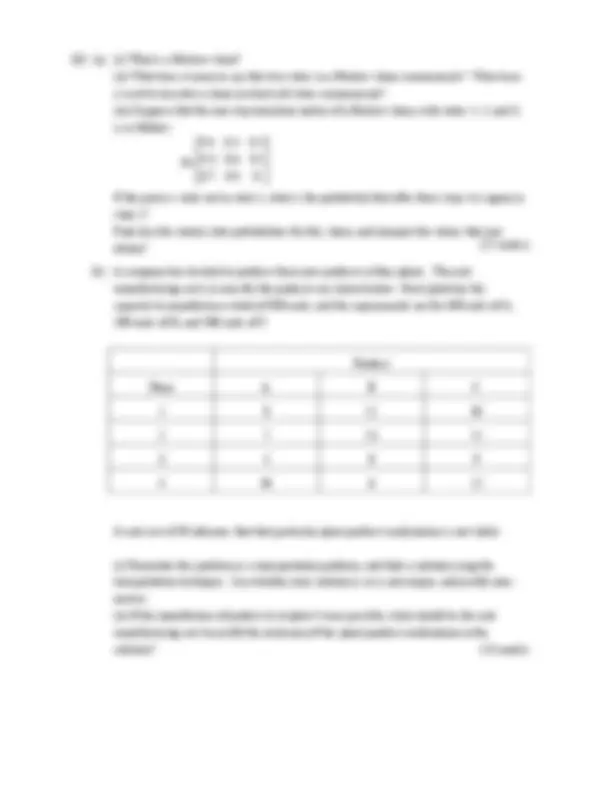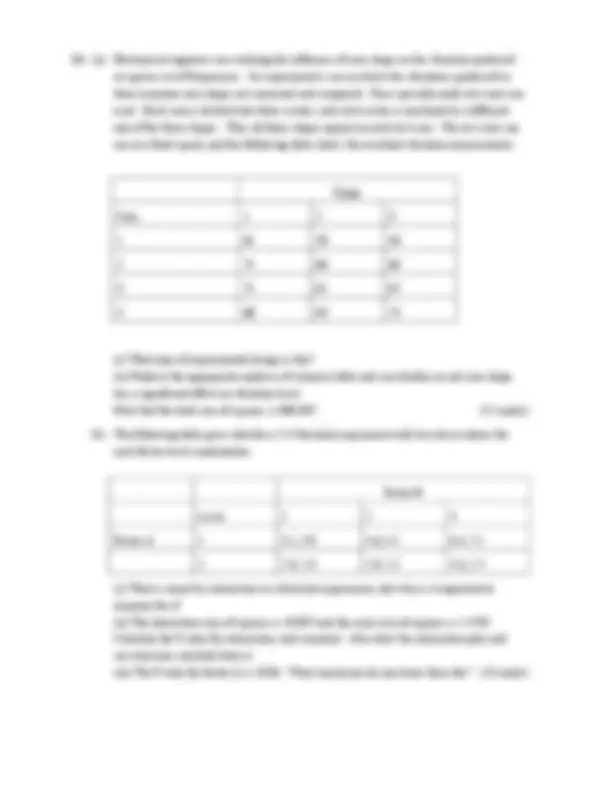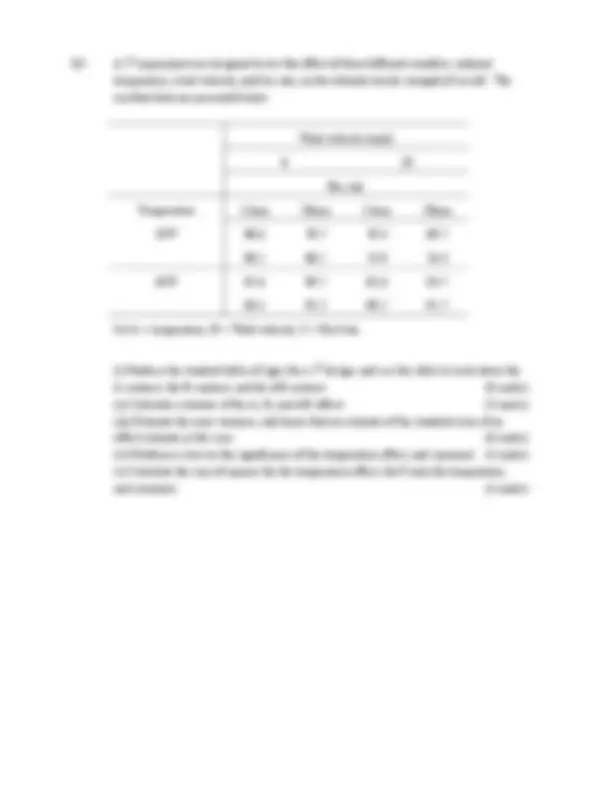





Study with the several resources on Docsity

Earn points by helping other students or get them with a premium plan


Prepare for your exams
Study with the several resources on Docsity

Earn points to download
Earn points by helping other students or get them with a premium plan
Community
Ask the community for help and clear up your study doubts
Discover the best universities in your country according to Docsity users
Free resources
Download our free guides on studying techniques, anxiety management strategies, and thesis advice from Docsity tutors
Solutions to linear programming problems related to determining the smallest number of operatives required for a continuous production process, using the m-technique or two-phase method to solve an lp problem, understanding markov chains and their properties, and analyzing experimental data to determine the effect of cam shape on vibration levels. The document also includes questions on finding the smallest number of operatives, using sensitivity analysis, calculating steady-state probabilities, formulating a transportation problem, and interpreting interaction in a factorial experiment.
Typology: Exams
1 / 6

This page cannot be seen from the preview
Don't miss anything!




(NFQ Level 8)
Instructions: Answer FOUR questions. All questions carry equal marks. Statistical tables are available.
Examiners: Mr. D. O’Hare Mr. J. E. Hegarty Prof. M. Gilchrist
Q1. For a continuous production process the number of operatives required are shown in the following table: Time of day 2.00-8.00 8.00-14.00 14.00-20.00 20.00-2. Minimum number of operatives
Each operative works 12 hours consecutively, and the objective is to determine the smallest total number of operatives needed to comply with the above requirements. (i) Show that the following LP model is appropriate:
subject to 2
minimise
1 2 3 4
3 4
2 3
1 2
1 4
1 2 3 4
x x x x
x x
x x
x x
x x
z x x x x
(4 marks)
(ii) The table below shows a basic solution that is infeasible but optimal. Use the dual simplex to solve the problem, and show that there are two solutions possible here. State both solutions clearly. (15 marks) Basis -z x 1 x 2 x 3 x 4 S 1 S 2 S 3 S 4 Solution. S 1 0 -1 0 0 -1 1 0 0 0 - S 2 0 -1 0 1 0 0 1 -1 0 4 x 2 0 0 1 1 0 0 0 -1 0 10 S 4 0 0 0 -1 -1 0 0 0 1 - (-z) 1 1 0 0 1 0 0 1 0 - (iii) Write down the dual of the problem in part (ii), and deduce its solution from that of the primal. (6 marks)
Q2. (a) Use the M-technique or the two-phase method to solve the following problem:
subject to 3 2 18
minimise 3 6
1 2
1 2
1 2
1 2
x x
x x
x x
z x x
(10 marks) (b) The incomplete table shown below relates to the following LP problem:
subject to 4 3 24
maximise 6 2 12
1 2 3
1 2 3
1 2 3
1 2 3
x x x
x x x
x x x
z x x x
Basis (^) z x 1^ x^ 2 x 3^ S 1^ S^ 2 Soln. x 3 (^) 1/ S (^) 2 -
(z) (i) Using the methods of sensitivity analysis, fill in the missing entries in the table, and describe the solution to the problem. (ii) Calculate the equivalent resource use of x 2 , and say what this value means. (iii) Suppose that the parameters on the right hand side of the constraints are changed to 24+α and 30+β respectively. Establish a pair of linear inequalities which α and β must satisfy in order that the current basis continues to be feasible, and outline the approach to dealing with a situation where α and β do not satisfy these inequalities. Find also a revised value for the objective function in terms of α and β. (iv) A further constraint, x 1 (^) + 2 x 2 + 3 x 3 ≤ 20 , is added to the problem. What now is the solution? (15 marks)
Q4. (a) Mechanical engineers are studying the influence of cam shape on the vibration produced at a given set of frequencies. An experiment is run in which the vibrations produced by three common cam shapes are measured and compared. Four specially made test cams are used. Each cam is divided into three sectors, and each sector is machined to a different one of the three shapes. Thus all three shapes appear on each test cam. The test cams are run at a fixed speed, and the following table shows the resultant vibration measurements.
Shape Cam 1 2 3 1 61 58 46 2 71 66 66 3 71 61 67 4 68 63 74
(i) What type of experimental design is this? (ii) Produce the appropriate analysis of variance table and say whether or not cam shape has a significant effect on vibration level. Note that the total sum of squares is 608.667. (12 marks) (b) The following table gives data for a 2×3 factorial experiment with two observations for each factor-level combination.
Factor B Level 1 2 3 Factor A 1 3.1, 4.0 4.6, 4.2 6.4, 7. 2 5.9, 5.3 2.9, 2.2 3.3, 2. (i) What is meant by interaction in a factorial experiment, and why is it important to examine for it? (ii) The interaction sum of squares is 18.007 and the error sum of squares is 1.4705. Calculate the F-ratio for interaction, and comment. Also draw the interaction plot, and say what you conclude from it. (iii) The F-ratio for factor A is 18.06. What conclusion do you draw from this? (13 marks)
Q5. A 2^3 experiment was designed to test the effect of three different variables, ambient temperature, wind velocity, and bar size, on the ultimate tensile strength of a weld. The resultant data are presented below.
Wind velocity (mph) 0 20 Bar size Temperature 12mm 20mm 12mm 20mm 20 °F 88.6 78.7 70.3 80. 90.2 80.1 74.9 76. 40 °F 92.6 99.7 82.6 93. 83.4 95.5 99.2 91. Set A = temperature, B = Wind velocity, C = Bar Size
(i) Produce the standard table of signs for a 2 3 design, and use this table to write down the A contrast, the B contrast, and the AB contrast. (8 marks) (ii) Calculate estimates of the A, B, and AB effects. (3 marks) (iii) Estimate the error variance, and hence find an estimate of the standard error of an effect estimate in this case. (6 marks) (iv) Perform a t-test on the significance of the temperature effect, and comment. (4 marks) (v) Calculate the sum of squares for the temperature effect, the F-ratio for temperature, and comment. (4 marks)